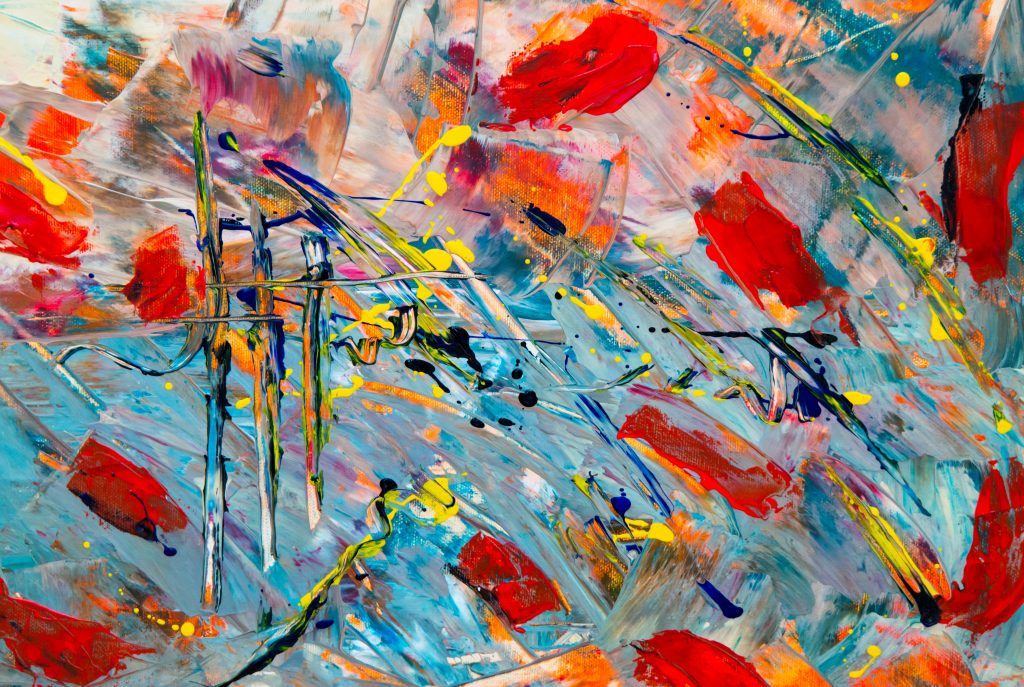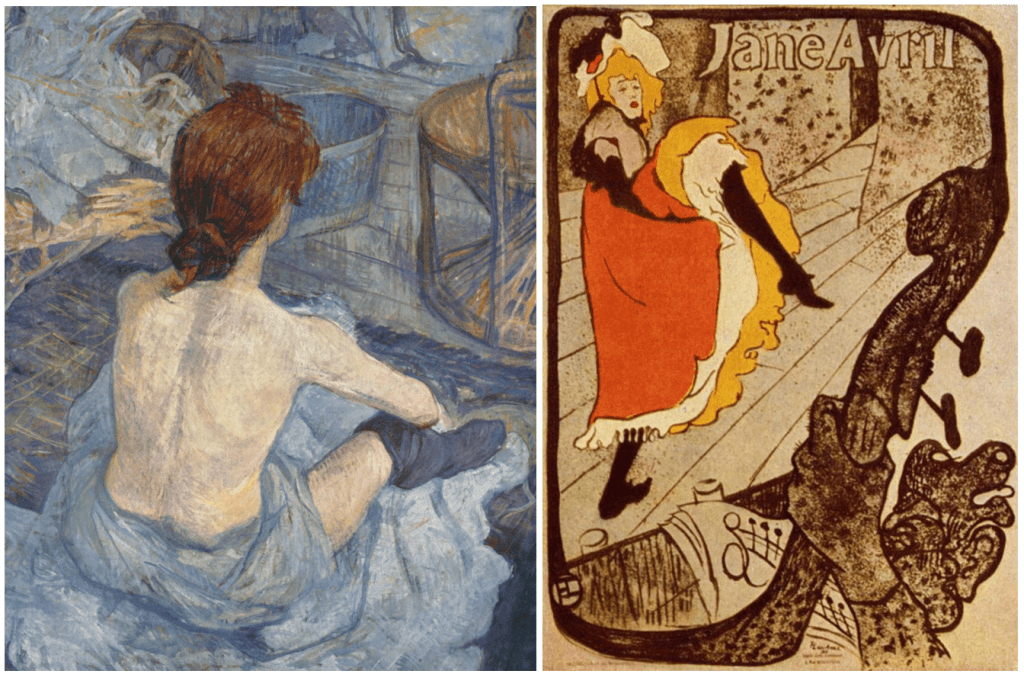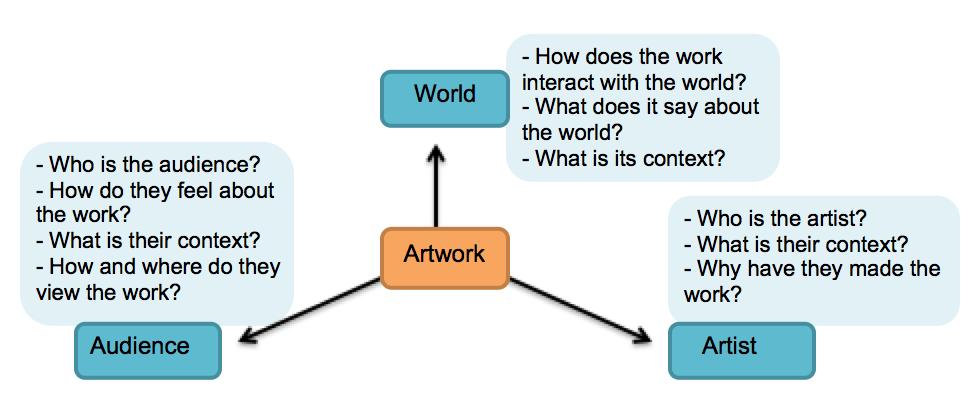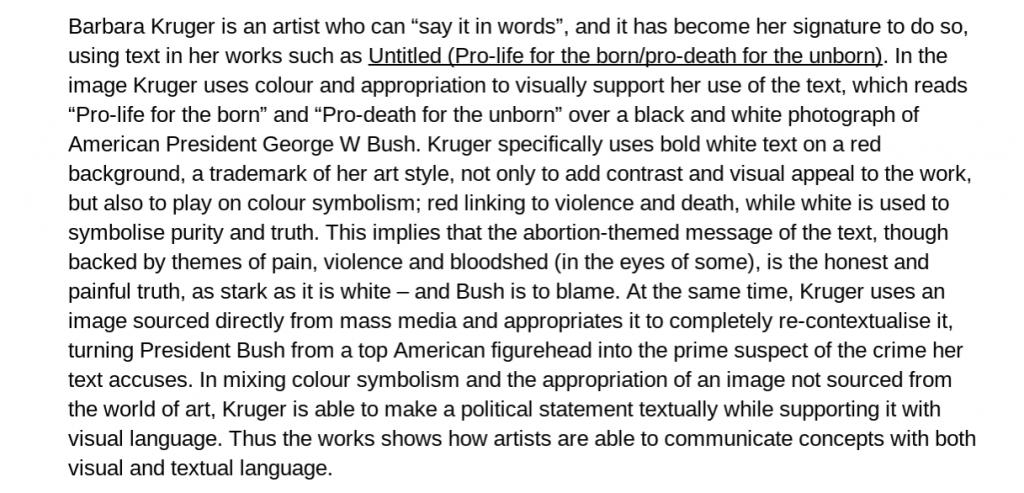
Writing a Visual Arts extended response can sometimes be the least of your worries, especially with the Visual Arts major work at hand.
However, it’s important to note that the HSC Visual Arts exam makes up 50% of your subject mark, which makes it important to know how to write a solid Visual Arts extended response!
But it doesn’t need to be as daunting, and confusing, as a lot of students make it out to be!
Let’s dig into how to write a Band 6 worthy Visual Arts extended response with this step by step guide!
What Makes a Band 6 Visual Arts extended response?
In order to write a Band 6 Visual Arts extended response you’ll need to know what one looks like, which we can do in two ways.
The first is to read a Band 6 Visual Arts extended response, which you can find here.
The other, more effective way is to read over the HSC syllabus and find out exactly what criteria you need to fulfil to receive a Band 6.
This way you know exactly what markers are looking for and what you need to include in your own writing in order to get the marks you want.
Though the individual questions of the HSC paper aren’t graded in bands, we’ll take the highest mark range (A) as being equal to a Band 6.
This is the criteria we have to meet in order to place in that mark range:
Let’s break it down into simpler terms:
- Presents an idea that makes sense and has evidence, but can show that other ideas are also valid
- Covers all parts of the idea while keeping it linked to the question
- Uses example artists and artworks to back up the idea
- All ideas make sense and go into detail, are complex
Essentially this means that in order to get high marks, your Visual Arts extended response has to focus on one central idea (usually given in the question) by looking at different ways of exploring the idea.
You also have to make sure to reference artists and artworks (at least 2 artists, at least 2 artworks each) to act as ‘evidence’ of whatever points you make.
It’s also important to remember that, like any essay, you have to remember your English skills – structure, sophisticated language, sentence flow, etc. are all important.
Your response is focused on Visual Arts, but any essay should be written as if you’re trying to impress an English teacher.
Aiming for a Band 6? Need some tailored feedback on your writing? Take a look at how our tutoring support in Bankstown can enhance your results!
Step 1: Choose Your Artists
The most important thing you have to bring to any Visual Arts extended response is your own knowledge of key artists and some of their artworks.
This means you’ll have to do a bit of research in class or in your own time to make sure your knowledge of these artists and works is in-depth and complex – you can’t just know that Van Gogh painted “that one picture of some stars and stuff”.
To write a strong Visual Arts extended response, you’ll need to write about at least 2 artists and at least 2 of each of their artworks (4 artworks all up).
Essentially 1 paragraph per artwork, per artist. This helps you structure your response, but is also central to making it a “complex” essay with “evidence/cases” as examples.
It’s much easier to write about what you care about, so go ahead and choose artists you like (but make sure they’re good, well-documented artists too).
Note: The goal is that by the end of the year you’ll know at least 2 artists and 4 artworks well enough to write about totally on-the-fly.
It’s also important to remember that you’ll be comparing and contrasting these artists, so choose two that share some similarities but are also different, and/or who come from different contexts.
A good idea is the “Idea vs. Practice” rule: if you want to focus on two artists who explore similar ideas, choose ones with very different practices, or vice versa. This way you’ll always have something to compare and contrast.
For example, have a look at Frida Kahlo and Del Kathryn Barton – they’re two artists who look closely at the notions of womanhood and femininity, however express it in completely different ways.
When studying artists, consider their artworks, practice, ideas and context:
- Artworks – which specific works of theirs will you write about?
- Practice – how do the create art? Materials, process, etc.
- Ideas – what topics or themes do they explore and how?
- Context – what time, place and society did they make art in?
This not only helps you understand the artist better, it also gives you a quick way to link everything back to the frames!
Artworks and practice are the structural frame, ideas are the subjective frame and context is the cultural frame.
This way you’re looking for information that will specifically help you write extended responses without falling into the trap of just grabbing whatever info looks most interesting and hoping for the best.
To break down specific artworks, simply use the frames:
- Structural – how is the work made? What does it look like?
- Subjective – how does it make you feel? What ideas does it reflect?
- Cultural – what time, place and society does it reflect?
- Postmodern – is it a take on an already existing work? Why/how?
Try to choose artworks that set the artists apart in some way – if they were known for a particular style or practice, focus on that.
Note: Be careful not to choose an artist’s most famous or popular work, as markers tend not to be impressed by obvious or ‘easy’ artworks.
Also remember to choose two artworks that are different for each artist – don’t choose two self-portraits by Picasso because they won’t give a “complex insight” into his work as an artist.
Let’s look at an example of two artworks by Henri di Toulouse-Lautrec below.

These two artworks by Henri di Toulouse-Lautrec show his focus on creating art of French women, specifically dancers at the Moulin Rouge, but two very different styles he used to explore the idea.
One of the best ways to build up your knowledge of important artists and artworks you may want to use in your responses is to fill out one of these cheatsheets whenever you learn about a new artist.
Obviously you’ll have to go into more detail if you want to write a strong response, but this is a good way to condense your information for quick recall!
Step 2: Choose a Question
In the HSC you’ll be given six questions worth 25 marks each to choose from when it comes to writing your extended response, but you only have to answer one.
There will be 6 questions, including:
- 2 x Frames questions
- 2 x Conceptual framework questions
- 2 x Practice questions
I’ll be completely honest with you; the frames based questions are always the easiest.
You know the frames well and have been talking about them since Year 7, making them by far the easiest to answer, but also the most popular questions.
If you choose to answer one of them you’ll most likely be choosing the same question as thousands of other students, which is fine so long as you can produce an awesome Visual Arts extended response!
The conceptual framework questions are trickier, because you have to really understand the framework to answer them fully.
Of course, you won’t have as much competition here, so if you study the framework hard in the lead up to the HSC you can easily pull off a great answer to an essay question here.
Practice questions tend to trip people up the most because they forget that they have to be focused on the practice, rather than the artwork itself.
This means you have to know the nitty-gritty details of exactly how the artist makes their artworks, specifically the works you’ve chosen to write about, but if you know the technical stuff you can smash these questions out of the park.
Unfortunately that’s where the predictions end, because every question is different and asks you to respond in a different way.
This means that you’ll need to be able to break down questions in order to know exactly how to answer them. Let’s grab an example from the past paper above.
By pulling out key phrases and words we can quickly break down exactly what the question is asking and what marker will want to see.
“With reference to this statement”
Whenever you’re given a quote, USE IT! Stick it at the end of your paragraphs as a link back to the question, quote it in your idea statements, relate it to the artists and artworks you’re writing about. The quickest way to lose marks is to forget to use/mention the quote in your response.
“Analyse how and why”
These are the ideas you’ll be exploring in your response – how your artists/artworks do something (e.g. through symbolism, use of colour, mixed media, etc.) and why they do something (e.g. to get audience reactions, to create emotion, to raise awareness, etc.). Make sure to discuss both the how and the why.
“Approaches other than realism”
This is what you’re going to be analysing the how and why of – styles other than realism (e.g. cubism, surrealism, caricatures, etc.). This doesn’t mean you can’t talk about realism, just that you need to talk about other styles too! For example, you may discuss how one artist uses realism to reflect real world issues, while another artist uses surrealist imagery to do the same thing. This is why it’s so important to choose artists who have difference, as it’s highly unlikely you would have chosen two artists who both work in a realistic style.
When it comes to actually answering the question you simply need to go through each artist and artwork one by one, looking at how they individually relate to the question and to each other.
For example, you may discuss how “Artwork A shows the value of realism, which contrasts Artwork B’s use of a cartoonist style to the same end, showing that ‘Art does not need to imitate life’ but it often does anyway.”
The best way to set yourself up for a Band 6 in a Visual Arts extended response is to choose the question you can answer best.
This means not going for the hard or impressive questions, or necessarily the easiest ones, but whichever one your artists, artworks and own writing style best suit.
Naturally, the only way to figure this is out is to write practise essays.
Practice essays are the only sure-fire way to:
- Figure out which question style you answer best
- Improve your extended response writing skills
- Get to know your artists and artworks super in-depth
By writing a whole bunch of practice essays (or essay plans) you’re able to really prepare yourself for writing a real Visual Arts extended response, and that way work out all the little issues you may end up having on the day.
Plus, repetition is the best way to memorise, so by the time you’ve written a few practice responses you’ll know your artists and artworks inside out!
Step 3: Consider the Frames and Conceptual Framework
Once you know what the question is asking and what artists and artworks you’ll use to answer it, you need to start thinking about what evidence you’ll use.
Whatever opinion, idea or argument you put forward in your Visual Arts extended response, everything you say needs to be backed up with artistic evidence, just like using quotes from texts in English essays.
The easiest way to find evidence? The frames and conceptual framework.
For a refresher on what each of these are and what they look at check out this article, but the chart and mind map below basically sum it up.
The Frames
| Structural What does it look like? How has the artwork been made? What techniques have been used? What materials have been used? What is the composition like? | Subjective How does it make you feel? What is the mood of the work? How is the mood created? What do you think the artist felt? What does the audience feel? |
| Cultural What is its context? When and where was the work made? How has this influenced it? Who was the artist? How did their context influence the work? | Postmodern Is it a new take on something? Does the work appropriate another artist? Does it appropriate another artwork? Why does it appropriate them/it? How has it changed the original meaning? |
Conceptual Framework

To provide evidence for a point, all you need to do is talk about how it relates to one of the frames or the conceptual framework, then link it back to the question.
This means that any time you reference the materials used to make an artwork, how the artwork makes audiences feel, what time the artists lived in and how the artwork reflects the world around it you’re basically giving evidence!
Let’s have a look at a partial sample from a Visual Arts extended response from the earlier question.

This example references a few key points that link back to the frames, the conceptual framework, and the question.
- “thin, jagged lines” – structural; how the work looks
- “sense of fragility and brittleness” – subjective; how it makes you feel
- “something has been damaged” – subjective; how it makes you feel
- “figure of a young, forlorn looking girl” – structural; how the work looks
- “audiences question if” – conceptual; how audiences and artwork relate
- “art doesn’t have to imitate life” – use of quote from question
- “non-realistic works to real-life experiences” – link to question
These are only small parts that link to the frames and conceptual framework, but by building them up throughout a full Visual Arts extended response you’re able to pack a whole lot of evidence into an essay!
Step 4: STEEL
Here’s where your English know-how comes into major play – it’s time to actually write your response!
Think of it as being just like an English essay, only instead of a text you’re looking at an artwork, and instead of literary techniques you’re using artistic ones!
STEEL is made up of:
- Statement
- Technique
- Example
- Effect
- Link
Statement
Introduce what your paragraph is about.
This should include which artwork and artist you’re discussing, as well as how you’re relating them back to the topic/question.
You may also want to include the year the artwork was made, its materials or other relevant information.
Technique
Now’s the time to mention what artistic techniques, materials or process have been used and start bringing in some of your evidence.
You may reference specific elements and principles of design, the frames, the conceptual framework, etc.
If it’s a practice-based questions (or you’re talking about practice) you can focus more on the materials used, how they were used, what styles and processes were used in the work, etc.
Example
This is where you go into artwork specifics and give your evidence of how the techniques is used by the artist in their artwork.
For example, if your technique was colour, talk exactly about how the artist has used colour – are the colours bright or muted? Are the complimentary or analogous? Is there colour symbolism involved?
Effect
Staying specific, this is the ‘why’ of your paragraph – basically telling us why all of the stuff you’ve already said is important.
Talk about how the techniques used in the artwork impact the artwork’s meaning, how audiences view it, etc.
Make sure to keep this section on-topic and focus on how all of these ‘effects’ tie back to the idea/topic presented in the original question.
Link
Finally, link everything you’ve said to the other artworks/artists you have talked about/will talk about, and then link it all back to the question.
Let’s try an example!
Question: “’If I could say it in words, there would be no reason to paint.’ – Edward Hopper. Discuss this statement with reference to how artists communicate concepts using a visual language.”

What Next?
So there you have it – a step by step guide to an awesome HSC Visual Arts extended response! We’ve given you all the elements you need to succeed, but now it’s up to you to get to work and start honing your skills.
Rome wasn’t built in a day, and neither will your writing skills be, so you’ll need to grab a few past paper questions and start trying out the skill you’ve learned here.
By adding all these elements together and editing your work to make sure it flows smoothly and sounds sophisticated you’ll have a band 6 Visual Arts extended response ready to go in no time!
So here’s a question for the road; choose your favourite artists, some awesome artworks and get writing!
Try using our HSC Visual Arts Essay Scaffold, combined with the STEEL technique to structure your response!
On the hunt for other HSC Visual Arts resources?
Check out some of our other articles/guides below!
- The Master List of HSC Visual Arts Practice Papers
- Finding Inspiration for Your HSC Visual Arts Major Work
- How to Write Effective HSC Visual Arts Study Notes
- How to Nail HSC Visual Arts Section 1 by Using a Scaffold
- How to Write a HSC Visual Arts Essay Using a Scaffold
Looking for extra help with HSC Visual Arts?
We pride ourselves on our inspirational HSC Visual Arts coaches and mentors!
We offer tutoring and mentoring for Years K-12 in a variety of subjects, with personalised lessons conducted one-on-one in your home or at our state of the art campus in Hornsby!
To find out more and get started with an inspirational tutor and mentor get in touch today!
Give us a ring on 1300 267 888, email us at [email protected] or check us out on Facebook!
Maddison Leach completed her HSC in 2014, achieving an ATAR of 98.00 and Band 6 in all her subjects. Having tutored privately for two years before joining Art of Smart, she enjoys helping students through the academic and other aspects of school life, even though it sometimes makes her feel old. Maddison has had a passion for writing since her early teens, having had several short stories published before joining the world of blogging. She’s currently studying a Bachelor of Design at the University of Technology Sydney and spends most of her time trying not to get caught sketching people on trains.





